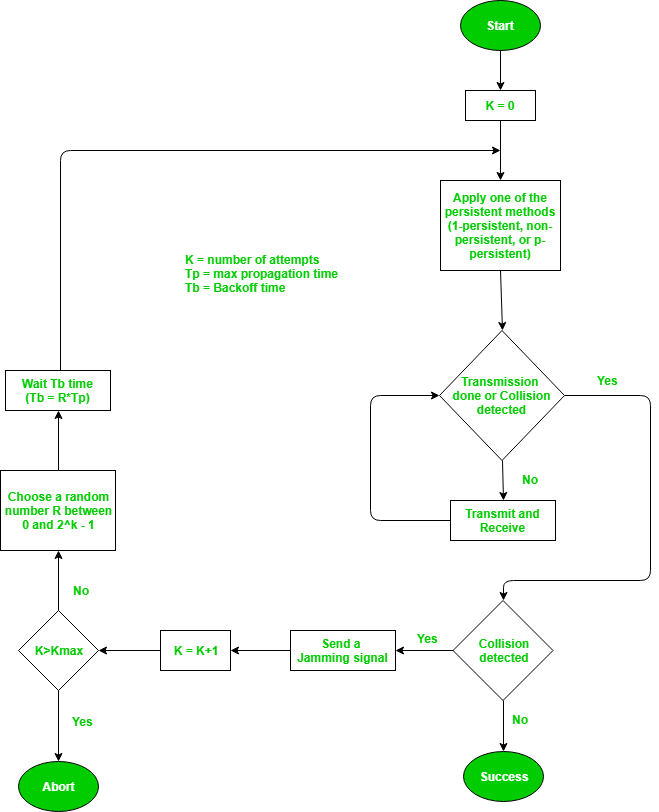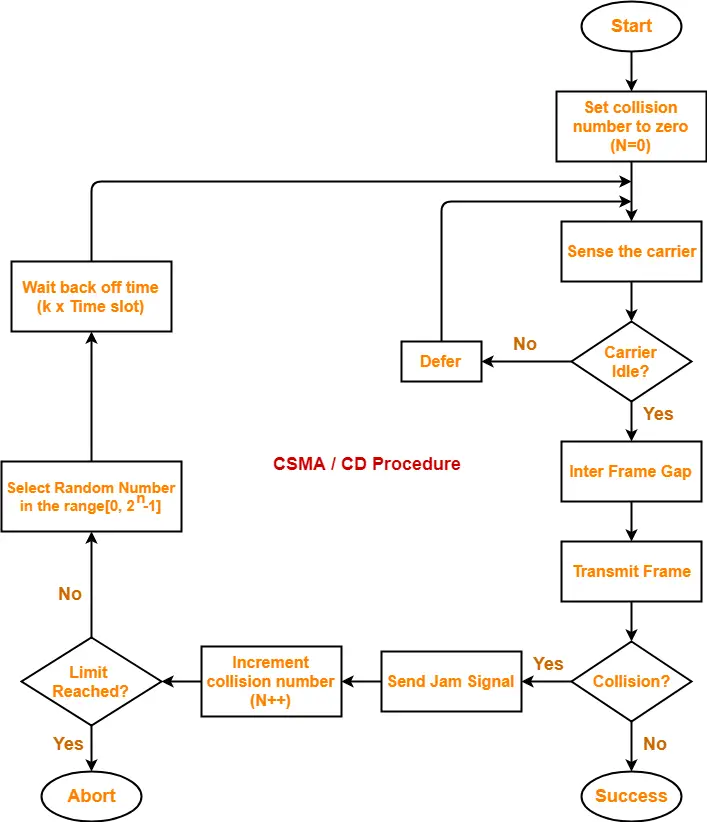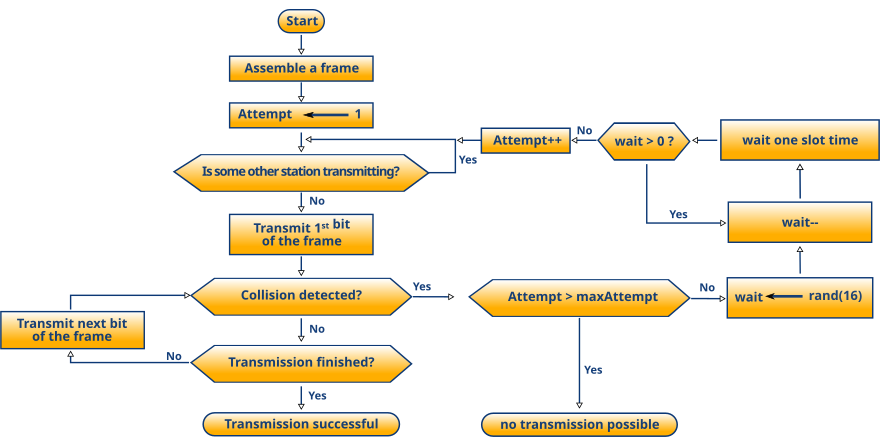Which of the Following Is True About the Csma/cd Algorithm
CSMA CD protocol stands for Carrier Sense Multiple Access Collision Detection. Non-reception of frame necessity of retransmission b.

File Flowchart Csma Cd Media Access Svg Wikimedia Commons
Algorithm for CSMA are.
. When a frame is ready the transmitting station checks whether the channel is idle or busy. Which of the following is true about the CSMACD algorithm. CSMACD detects whether the channel is free or busy before transmitting data so that it can avoid collision whereas ALOHA cannot detect before transmitting and thus multiple stations can transmit data at the same time.
When two or more nodes try to send data. This algorithm is generally used in Ethernet to schedule re-transmissions after collisions. Collisions can happen but the algorithm defines how the computers should notice a collision and how to recover.
It is a carrier sense multiple access collision detection network protocol to transmit data frames. Non-Persistent 1-Persistent and 2-Persistent. CSMACD stands for Carrier Sense Multiple AccessCollision Detection with collision detection being an extension of the CSMA protocol.
BNone of the other answers is correct. It listens at the same time on communication media to. Back Off Algorithm- After undergoing the collision.
The algorithm never allows collisions to occur. CThe cable can be up tio 1000 meters long to cross over between buildings. The algorithm never allows collisions to occur.
Transmit if medium is idle otherwise go to 2. Algorithm For CSMA. All of the above View Answer Hide Answer.
BThe algorithm never allows collisions to occur. What conclusion can be drawn if the collision is detected in CSMACD algorithm while controlling the access in wireless LANs. A CSMACD b CSMACA c Both CSMACD CSMACA d HDLC Answer.
Which of the following is true about the CSMACD algorithm. The algorithm works with only two devices on the same Ethernet. APins 1 and 2 are reversed on the other end of the cable.
If the channel is busy the station waits until the channel becomes idle. If channel is not free then wait for random amount of time then sense the channel if free then sends the data. None of the other answers is correct.
Back Off Algorithm is used for calculating the back off time. The algorithm never allows collisions to occur. While CSMACD attempts to avoid collisions it also notices when collisions do occur with rules about how the Ethernet nodes should stop sending wait and try again later.
Back Off Algorithm or Binary Exponential BackOff Algorithm is used to calculate back off time. DPins 1 and 2 on one end of the cable connect to pins 3 and 4 on the other end of the. This creates a procedure that regulates how communication must take place in a network with a shared transmission medium.
CSMACD is commonly used in networks with repeaters and hubs because these devices run in the half. CSMACD is abbreviation for Carrier Sensing Multiple AccessCollision detection. None of the other answers is correct.
No necessity to prevent the signal fading d. The algorithm works with only. Following 8 cases are possible- Station A.
Collisions can happen but the algorithm defnies how the computers should notice a. These are explained as following below. The extension also regulates how to proceed if collisions occur ie.
No necessity of working in duplex mode for the host c. Collisions can happen but the algorithm defnies how the computers should notice a collision and how to recover. Back-off algorithm is a collision resolution mechanism which is used in random access MAC protocols CSMACD.
None of the other answers is correct. Collisions can happen but the algorithm defines how the computers should notice a collision and how to recover. The algorithm of CSMACD is.
None of the other answers is correct. This waiting time for which the station waits before retransmitting the data is called as back off time. Which of the following is true about the CSMACD algorithm.
The main difference between ALOHA and CSMACD is that ALOHA does not possess the feature of carrier sensing like CSMACD. CSMACD is a protocol in which the station senses the carrier or channel before transmitting frame just as in persistent and non-persistent CSMA. Which of the following is true about the CSMACD algorithm.
The algorithm never allows collisions to occur. 2Which of the following is true about Ethernet crossover cables for Fast Ethernet. ANone of the other answers is correct.
Collisions can happen but the algorithm defines how the computers should notice a collision and how to recover. In CSMACD it deals with detection of collision after collision has occurred whereas CSMACA deals with preventing collision. In CSMA CD protocol After the occurrence of collision station waits for some random back off time and then retransmits.
The CSMACD protocol works with a medium access control layer. The algorithm works with only two devices on the same Ethernet. The algorithm works with only two devices on the same Ethernet.
If the channel is busy the station waits. If a collision takes place between 2 stations they may restart transmission as soon as they can after the collision. This algorithm helps devices on the same network segment to decide when to send packets and what to do in case of collisions.
NICs and switch ports use the carrier sense multiple access with collision detection CSMACD algorithm to implement half-duplex logic. To reduce the impact of collisions on the network performance Ethernet uses an algorithm called CSMA with Collision Detection CSMA CD. 3Which of the following is true about the CSMACD algorithm.
IEEE 80211 wireless LAN runs CSMACD protocol Ethernet is not based on CSMACD protocol CSMACD is not suitable for a high propagation delay network like satellite network There. Half-duplex Ethernet networks use an algorithm called Carrier Sense Multiple Access with Collision Detection CSMACD. Practice Problems based on CSMA CD and Back Off Algorithm.
Therefore it first senses the shared channel before broadcasting the frames and if the channel is idle it transmits a frame to check whether the transmission was successful. Which of the following statements is TRUE about CSMACD. If the channel is idle the station starts transmitting and continually monitors the channel to detect collision.

Carrier Sense Multiple Access Csma Geeksforgeeks

Binary Exponential Backoff Algorithm Csma Cd Gate Vidyalay

Carrier Sense Multiple Access With Collision Detection Wikiwand
Comments
Post a Comment